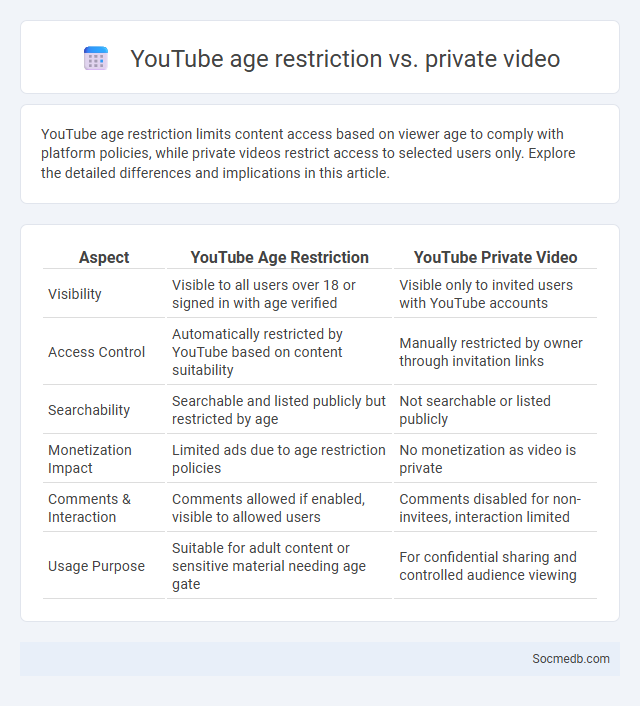
Photo illustration: YouTube age restriction vs private video
YouTube age restriction limits content access based on viewer age to comply with platform policies, while private videos restrict access to selected users only. Explore the detailed differences and implications in this article.
Table of Comparison
| Aspect | YouTube Age Restriction | YouTube Private Video |
|---|---|---|
| Visibility | Visible to all users over 18 or signed in with age verified | Visible only to invited users with YouTube accounts |
| Access Control | Automatically restricted by YouTube based on content suitability | Manually restricted by owner through invitation links |
| Searchability | Searchable and listed publicly but restricted by age | Not searchable or listed publicly |
| Monetization Impact | Limited ads due to age restriction policies | No monetization as video is private |
| Comments & Interaction | Comments allowed if enabled, visible to allowed users | Comments disabled for non-invitees, interaction limited |
| Usage Purpose | Suitable for adult content or sensitive material needing age gate | For confidential sharing and controlled audience viewing |
Understanding YouTube’s Age Restriction Policy
YouTube's age restriction policy limits access to videos deemed inappropriate for viewers under 18 by enforcing age verification and content filtering mechanisms. This policy helps protect younger audiences from exposure to mature content, including explicit language, violence, or adult themes, ensuring compliance with legal and community standards. Creators must label sensitive content accurately, or YouTube may apply restrictions automatically based on algorithmic detection and user reports.
What is a Private Video on YouTube?
A Private Video on YouTube is a video setting that restricts access to only the users you specifically invite, making it invisible to the public and unsearchable on the platform. Your private videos can be shared with up to 50 people by adding their email addresses, ensuring that only trusted viewers can watch your content. This setting offers enhanced control over who sees your videos, ideal for sharing personal or sensitive content securely.
Age Restriction vs Private Video: Key Differences
Age restriction on social media limits content visibility to users above a specified age, ensuring compliance with legal standards and protecting minors from inappropriate material. Private videos restrict access by allowing only selected users or followers to view the content, enhancing privacy and control over audience engagement. These features serve distinct purposes: age restriction enforces regulatory compliance, while private video settings prioritize user privacy and selective sharing.
How YouTube Enforces Age Restrictions
YouTube enforces age restrictions by requiring users to sign in and verify their age before accessing age-restricted content. The platform uses automated systems and community flagging to identify videos containing mature themes, subsequently restricting access to users under 18. If YouTube detects a violation, it may remove the video or apply age-gating measures to protect younger audiences and ensure compliance with content policies.
Benefits and Limitations of Age-Restricted Content
Age-restricted content on social media ensures that sensitive or mature material is only accessible to users above a certain age, protecting younger audiences from inappropriate exposure and complying with legal regulations. You benefit from a safer online environment where content is tailored to age-appropriate standards, reducing the risk of harmful influences and enhancing user trust. However, limitations include potential inaccuracies in age verification processes and the challenge of balancing content accessibility with user privacy and freedom.
When to Use Private Videos on YouTube
Private videos on YouTube are ideal when you want to restrict access to specific individuals, such as sharing personal content with family or collaborators without making it public. Your private videos remain invisible in search results and to anyone without explicit permission, ensuring confidentiality and control over who views your content. Use the private setting to securely distribute drafts, sensitive information, or exclusive footage to selected viewers.
Privacy Controls vs Age Restrictions: Best Practices
Implementing robust privacy controls alongside age restrictions is essential to safeguarding user data and maintaining compliance with regulations like COPPA and GDPR. Best practices involve customizable privacy settings that limit data sharing based on verified age, ensuring minors are protected from inappropriate content and targeted advertising. Regular audits and transparent user communication strengthen trust and enforce responsible social media engagement across diverse age groups.
Content Visibility: Age-Restricted vs Private Videos
Age-restricted videos on social media limit Content Visibility by preventing access to users below a certain age, ensuring compliance with platform policies and legal regulations. Private videos further restrict visibility by allowing only selected viewers, significantly reducing audience reach but enhancing content control and privacy. Understanding these distinctions is crucial for optimizing Your social media strategy and targeting the desired demographic effectively.
Monetization Impacts of Age Restriction and Private Setting
Monetization on social media platforms is significantly affected by age restrictions, as advertisers often limit campaigns to users above certain age thresholds to comply with legal and ethical standards, reducing potential revenue from younger audiences. Private account settings constrain content reach, lowering engagement rates and diminishing ad impressions, which directly impacts creators' and platforms' earning potential. Platforms must balance user privacy preferences with monetization strategies, implementing targeted ad solutions that respect age demographics and privacy settings to optimize revenue streams.
Choosing the Right Option: Age Restriction or Private Video
Choosing between age restriction and setting your video to private depends on your content's target audience and privacy needs. Age restriction helps ensure viewers meet the legal age requirements, protecting your content from underage access, while private videos limit visibility exclusively to selected users. Understanding your video's purpose helps you decide which option best safeguards your content and aligns with Your distribution goals.
 socmedb.com
socmedb.com